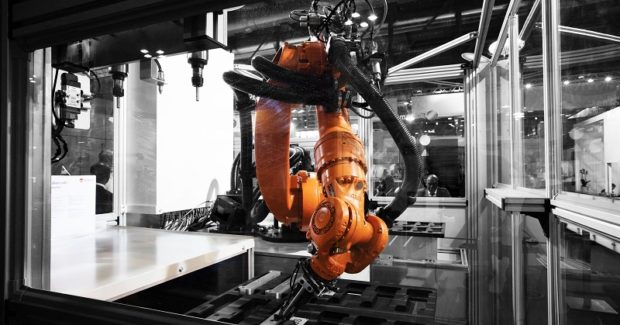How Robotics Can Offset Trade Cost Hikes
To offset the rising cost of metals and avoid hurting their bottom lines, many shops are turning to robotics for repetitive-based processes to help optimize their workforce productivity through precision and consistency.
Posted: February 6, 2019
The tariffs on steel and aluminum have had an uneven impact on metal fabricators: Some shops can afford to switch to a domestic supplier, others try requesting an exemption from the tariffs, though the odds of receiving exclusion status is slim. Still others have no choice but to import if the metals they need aren’t readily available in America. Regardless of where these shops source their material, rising material prices threaten to place financial strain on their competitiveness. Left with few options to offset the rising cost of metals and avoid hurting their bottom lines, many companies are turning to robotics. Rather than wait for import taxes to drop or lay off workers to minimize labor expenses, they are adopting robots for repetitive-based processes to optimize workforce productivity. For example, welding robots are quickly becoming a mainstay in metalworking because of their precision and consistency.
Robotic welders never get tired while producing consistent, optimal welding quality. With high axis velocities and exceptional path accuracy, they minimize any unproductive motions and ensure accurate positioning at the beginning of a weld seam. Robots significantly boost productivity by consistently churning out high quality products and simultaneously working on multiple components at once. They lower operating costs by protecting humans from hazardous working conditions that can result in expensive repercussions. As careful as human workers are, they can still make costly mistakes that shops must absorb in wasted materials or accident-related expenses. Robotic welding can shorten the return on investment through increased productivity, reduced scrap losses and minimal first-time weld failures. Consistent arc performance from robots ensures high weld pass rates the first time around, reducing money spent fixing weld failures and time wasted due to disrupted workflows. One estimate reports that automated workflows can reduce costs by roughly 22 percent for American companies, a welcome savings for shops paying a premium on imported steel and aluminum.
Tariffs or not, robots will continue to revolutionize the metalworking business because they enable shops to work smarter, not harder. But they are still simple machines, limited in their capabilities and often requiring a human partner to complete processes. Advancements in technology have made it easier than ever for shops to set up robotic systems, but humans still need to program them based on application needs. Common misconceptions view robots as competitors for already scarce jobs, leaving some companies reluctant to embrace robots entirely. To alleviate any fears of job displacement, companies considering robotic systems should take time to explore where these machines fit in an existing operation and how to introduce workforces to new systems. For example, collaborative robots (cobots) can work alongside human operators, encouraging them to embrace automation while minimizing potential injuries on the shop floor. Smart sensors help cobots identify obstructions in their work and instruct them to stop before incidents escalate, eliminating the need for hard guarding and constant surveillance.
Until the tariff disputes are resolved, manufacturers risk hurting their bottom line if they choose to absorb input costs without adjusting their operating and labor expenses. They may have little to no influence regarding trade policies, but they can control how to allocate their resources and minimize operating costs to offset rising prices. Investing in technologies such as robots can help them maintain high levels of profitability and productivity, even if the trade tariffs remain.





